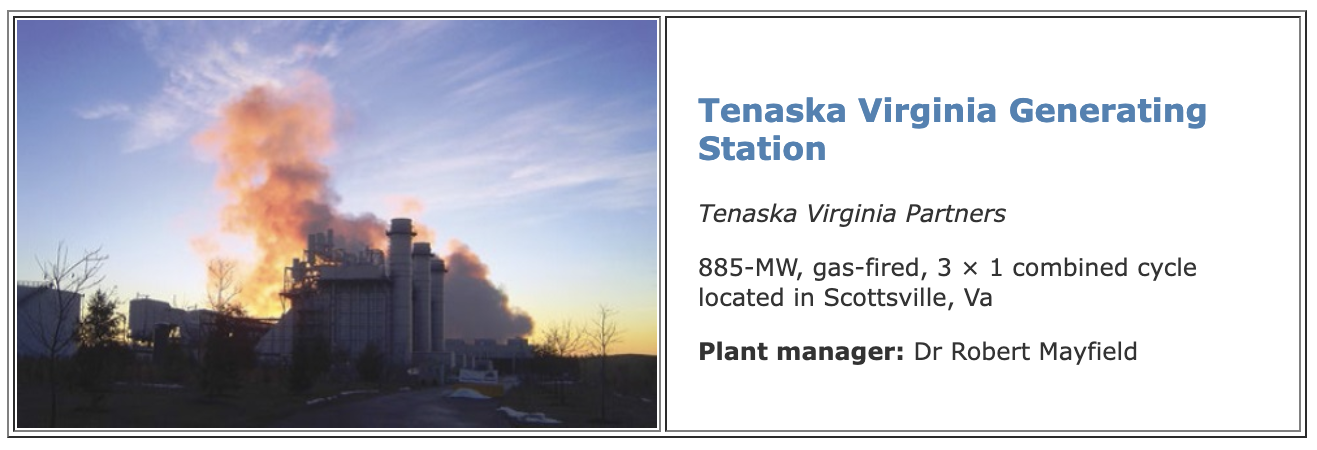
Building a 21st-century workforce begins with education
Best of the Best Award
Challenge. Approximately half the workforce in the electric-utility sector will retire in the next 10 years, according to the US Bureau of Labor Statistics. That will leave a shortage of experienced workers in every organizational facet. This shortage has the potential to adversely affect energy reliability and innovation nationwide.
Solution. The number of students entering the electric generation business is not sufficient to support the coming need, with surveys showing that (1) most high-school students do not know much about power production and do not feel confident enough in their math and science skills, and (2) few parents encourage their children, particularly girls, to consider a career in the generation business.
A partnership between business and education, built around economic and workforce-development needs is necessary to attract the best talent to operate future powerplants. TVGS has collaborated with the local education system to help bridge the gap that exists today between the classroom and the workplace in the following ways, among others:
- Communicated an image of an engineer/operator as someone who solves problems that make a difference in the world.
- Increased the interest among youth in math, science, technology, and engineering (STEM).
- Improved the quality of secondary-school engineering programs by helping Fluvana County’s high school become one of a dozen in the state to be awarded the Dept of Education’s “Project Lead the Way.”
- Worked with education to provide energy generation projects, plant field trips, and learning-by-doing experiences—such as how geometry is used at the plant—to increase student interest in the electric-power business.
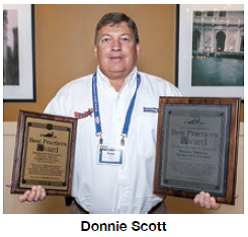
- Sponsored a high-school robotics team and a middle school LEGOs team which were entered in the state competitions (Fig 1).
- Provided schools science-expo judges.
- Purchased mechanical-drawing and media equipment for the high school.
- Sponsored the high-school Imagination Team and 24 Math Card tournaments.
- Provided the high school four annual college scholarships.
- Sponsored over 250 local teachers the opportunity to attend a night of comedy and dinner to show the plant’s education appreciation.
- Hired a summer engineering intern.
- Provided engineering guest speakers for the statewide seventh- and 10th-grade Career Days.
- Provided plant guest speakers for the statewide eighth-grade Career Scholars Day.
- Promoted Career and Technical Education (CTE) programs throughout the state.
- Sponsored two annual spelling bees.
- Purchased 50 calculators for the high-school math department.
- Tutored middle-school math.
- Arranged tours of the facility both for students and teachers.
- Sponsored a teacher appreciation workday lunch for over 400 teachers.
- Sponsored a program enabling the high-school art department to support students in the drawing of pictures of TVGS for display throughout the plant’s admin building (Fig 2).
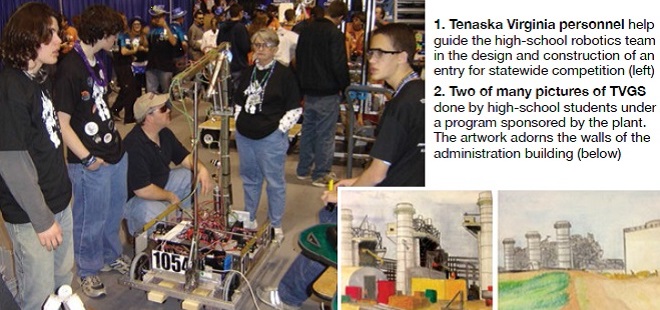
Results. Getting a positive word to the community and the local universities has sparked a renewed interest in the power generation business. Every morning, the high-school media department shows a 10-sec clip on how TVGS helps to support education. TVGS Operations Manager Donnie Scott says the key to success is simple, “We must start at the beginning to get the younger generation to take more math, science, technology, and engineering classes in middle school.”
Project participants:
Plant Manager Dr Robert Mayfield
Operations Manager Donnie Scott
Maintenance Manager Sam Graham.
Exterior plant lighting inspection, improvements
Best Practices Award
Challenge. Exterior plant lighting supports plant safety, energy savings, and security elements—such as visual identification capability, personnel safety, and effective lighting for security cameras.
Solution. Continuous improvement is integrated into the management and operational fabric of the company. The company’s simple approach to continuous improvement is a three-step process that defines, measures, and improves. The plant’s process improvement team focused on measures and processes, and sought out interaction and consensus among the process owners. Applying the three-step process to inspecting exterior lighting fixtures, the O&M teams had to (1) identify true causes of problems, (2) find solutions that evidence shows are linked to the causes, and (3) establish procedures for maintaining the solutions even after the project was complete.
The plant conducts monthly inspections on 454 exterior lighting fixtures. These inspections were time-consuming for the following reasons:
- Duplication of inspection efforts.
- Unnecessary inspection steps.
- Lighting breakers not listed for isolation.
- Light bulb sizes not listed.
- Duplication of work orders.
- Work orders not consistent.
- No follow up on repairs.
Results. The team spent six months developing an exterior lighting numbering system which contained information pertaining to the exterior light fixtures. The scope of the project determined that there were 454 exterior lighting fixtures and four different bulb sizes. Twenty-two maps (Figs 3, 4) were drawn showing the physical locations of the fixtures, fixture number, and bulb wattage type. This system saved countless operator inspection hours, saved energy, and ensured 100% of the exterior lights were working.
Project participants:
The entire TVGS staff
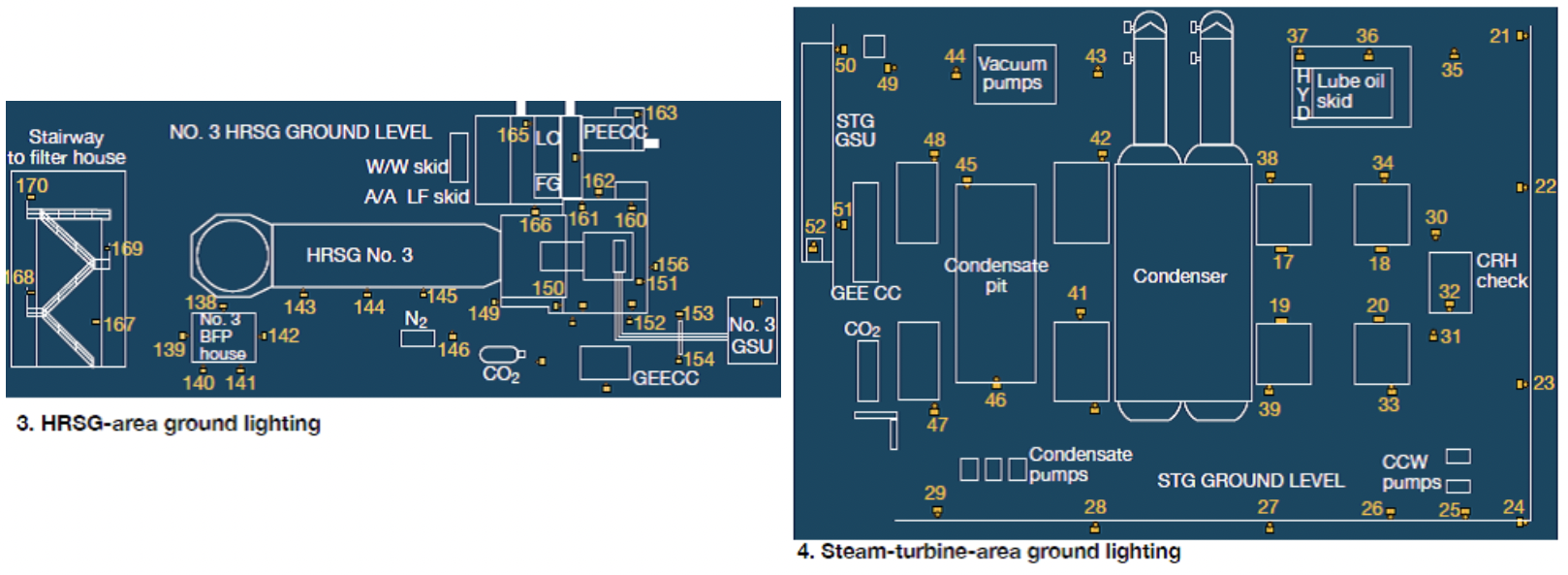
Contractor safety key component to OSHA VPP Star status
Challenge. OSHA’s Voluntary Protection Programs recognize and partner with businesses and worksites that exhibit excellence in occupational safety and health. Sites are committed to effective employee protection beyond the requirements of OSHA standards. VPP participants develop and implement systems to effectively identify, evaluate, prevent, and control occupational hazards to prevent employee injuries and illnesses. Contractor safety is a major component in being awarded the OSHA VPP Star.
Solution. Tenaska Virginia has incorporated the following into its contractor safety program which is being used by OSHA as a model:
- Contractor Safety Verification Questionnaire.
- Proof of contractor insurance.
- Explain site access instructions so contractors know what to expect when they get on site the first day (security, briefings, etc).
- Site requirements: site access, speed limits, possible vehicle searches, weapons rules, parking/vehicles access, tools, cleanliness, fall protection, PPE, evacuation route, etc.
- Inspect all contractor equipment used on site (forklifts, man lifts, etc).
- Ensure contractors fully understand the plant’s safety standards.
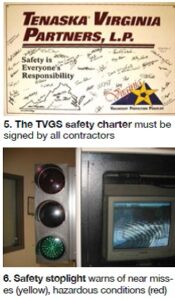
- Contractors to participate in the “job hazard analysis” process.
- Contractors must have a translator on site if the company uses non-English-speaking employees.
- Annual contractor written exams both in English and Spanish.
- Each contractor is listed in a database and issued a serial number.
- Safety walk-down inspections are required every work shift.
- Any employee can stop work for safety violations.
- Any employee can stop work for housekeeping violations.
- Approve all contractor chemicals prior to use on-site.
- Daily LOTOs are always reviewed.
- Ensure contractor understands there is no chemicals discharge allowed from the plant.
- An employee is assigned to contractors.
- An employee is our outage coordinator.
- New contractors are required to sign the plant’s safety charter (Fig 5).
- Obtain and verify adequate spill containment equipment.
- Stage spill kits, dumpsters, waste barrels, and smoking areas.
- Communicate waste disposal areas/rules.
- An outage safety barbecue is held with all contractors and employees to express the importance of following our safety policies, sharing safety ideas, and understanding our commitment to safety and “esprit de corps”.
- A safety traffic stop light is mounted in the control room (Fig 6). This stoplight shows the colors red, yellow, and green. Green light represents no safety near misses or missed opportunities; a yellow light indicates a near miss; a red light indicates an accident or hazardous situation.
- Contractor supervisors and all employees are required to sign the plant’s safety charter. This ensures we are all on board in maintaining an open honest safety culture.
- Every year the facility votes for our “Contractor of the Year.”
Results. OSHA is using our contractor safety program as a benchmark for future OSHA VPP inspections. We were recertified as OSHA VPP Star in 2013.
Project participants:
Plant Manager Dr Robert Mayfield
Operations Manager Donnie Scott
Maintenance Manager Sam Graham



